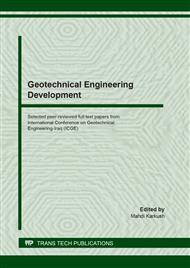p.283
p.292
p.302
p.311
p.319
p.328
p.334
p.341
p.349
Analytical Study of Load-Settlement Behavior of Soil Treated with Stone Columns have Different Sectional Shape
Abstract:
Stone columns have been used widely to improve the engineering properties of the weak soil. Most of the previous works considered a circular section for the stone columns. In the present study, finite element analysis has been carried out to investigate the effect of stone columns shape and length on the settlement and bearing capacity of soft soil. Accordingly, three types of cross sectional shape for stone columns have been selected which they are circular, rectangular, and square sections with equivalent area. Various length of columns are adopted with diameter of 0.75m that achieved length to diameter or equivalent diameter ratios (L/d=2, 4, 6, 8, and 10) of columns spacing (S/d=3). The results show that the stone columns has tangible effects on the settlement of the soil while has minor effects on the bearing capacity. The settlement of the treated soil with stone columns have L/d=2, reduces by 18.0, 17.3, and 19.3% for circular, rectangular , and square sections respectively. With increasing length of the columns to L/d=10, further reductions in the settlement obtained of (27.1, 28.1, and 27.0%). Bearing capacity of the soil increased slightly with length of the stone columns. Almost all cross sectional shapes of the columns give bearing capacity about same. The increased in the bearing capacity of the treated soil with stone columns have L/d=2, not exceeded 10% for all sectional types. The average increments in bearing capacity when L/d=10 are 12 and 15% at settlement 50 and 100mm respectively. Insignificant changes in bearing capacity upon increasing length of columns from L/d=2 to 10 of maximum 5%. The plastic zone recedes with the increasing length of the stone columns. Finally, from the results obtained, it can be concluded that the stone columns shape has negligible effects on the settlement and bearing capacity of the soil.
Info:
Periodical:
Pages:
319-327
Citation:
Online since:
August 2020
Authors:
Keywords:
Price:
Сopyright:
© 2020 Trans Tech Publications Ltd. All Rights Reserved
Share:
Citation:


